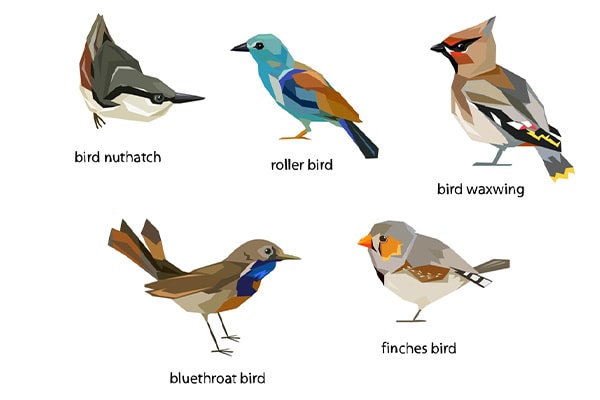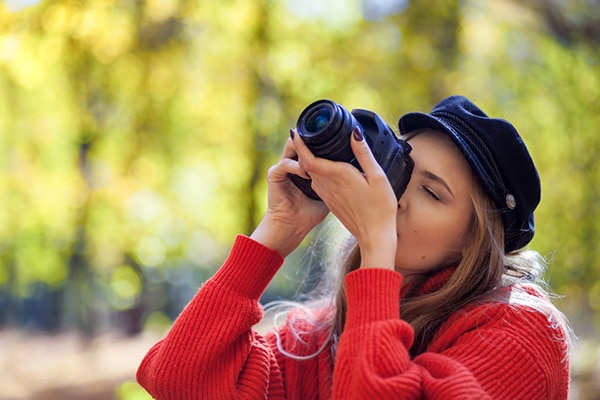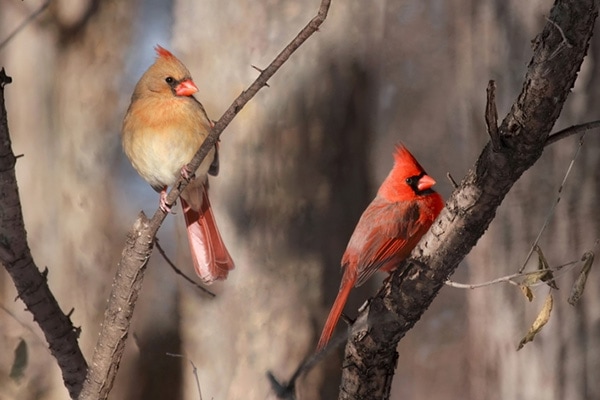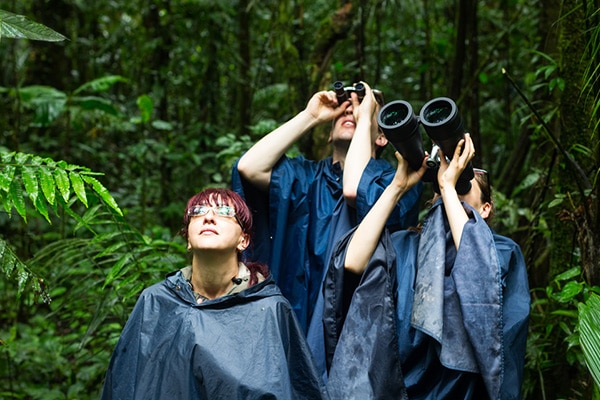Contents
- Strategy #1. Practice Consciously Looking and Watching
- Strategy #2. Use Your Eyes And Ears
- Strategy #3. Try To Get Closer
- Strategy #4. Use Binoculars
- Strategy #5. Learn One Bird At A Time
- Strategy #6. Get Familiar With The Most Common Birds First
- Strategy #7. Take Notes
- Strategy #8. Take Photographs
- Strategy #9. Practice Sketching Birds At Home
- Strategy #10. Get Outside With Other Bird Lovers
- Strategy #11. Compare Male vs. Female Birds
- Strategy #12. Use Field Guides Appropriately
- Strategy #13. Read Birding Magazines
- Strategy #14. Make Mistakes and Keep Going
- Final Thoughts On Strategies For Improving Your Bird ID Skills
There are over 10,000 bird species worldwide, and 800 of those are found in the US and Canada. So, while bird watching is a fun activity, it is no surprise that bird identification can be challenging, even for experts.
Birds are constantly moving, changing behaviors, and certain species can look very much alike. That’s why no one can ever be so sure when it comes to pinpointing certain bird species. And no matter what anyone says, bird identification is a skill – a skill that you need to hone and improve as a bird watcher.
In this article, we will tackle 14 strategies that will help you improve your bird identification skills. This way, the next time you get to the field, you can start identifying birds better and with more confidence.
These strategies are perfect for beginner birders and can also help even those who have been in this field for years. As long as you love birds and bird watching, this is for you!
Strategy #1. Practice Consciously Looking and Watching
Bird watching requires patience. Lots of patience.
Often, newbies would just:
- Go to the field
- Find a bird
- Watch it for a few seconds
- Walk away to find another bird
They do this with all the other birds they find, and by the time they get home to check the field guide or the internet, things have already become very confusing.
Because while the term bird watching may mean watching birds, identifying species takes more than just simply looking at it.
This is not a race of who found the most birds in one day. So, don’t just simply look. Slow down and spend plenty of time watching and observing certain bird species before moving on to the next one.
It doesn’t matter how long you’d have to stay there and observe the bird from every angle. Some may probably take around 10 minutes.
Of course, we’re not saying you need to spend 10 minutes on every bird you see. This is only particular on species that you’ve just seen or if you’re a newbie. Because spending high-quality time on one bird today, may mean surely identifying the same species for only 30 seconds the next time you see it.
Strategy #2. Use Your Eyes And Ears
The key to identifying birds carefully is by using your eyes and ears. What do we mean by this? Well, while you’re quietly watching and observing the birds you see, you may want to carefully identify them using the following clues.
Size
When it comes to identifying birds, you need to start with the basics. You don’t start with small details like eye patches, wing streaks, or stripes in the tail. While these things may be remarkable identifiers, these are not the first things you’ll see when you’re in the field.
That’s why it’s essential to start with the most visible bird trait – its size.
One of the first questions you need to ask is, “How big is this bird compared to other birds?”
For this question, you need to build up a primary size reference. For example:
- Sparrow-sized
- Robin-sized
- Crow-sized
- Eagle-sized
This way, every time you see and start identifying a bird, you can easily differentiate its bird size from the other birds.
For example, one bird might be bigger than crows but smaller than eagles, another bird can be bigger than robins but smaller than crows, some birds are just sparrow-sized, and so on.
Then, you can check the birds on your list belonging to that category size, making identification a lot easier.
You might even reach a point where you no longer have to check your list because your eyes will be trained enough to differentiate a raven from a crow, even from far distances.
Beak
Another essential thing you should observe is the size of the bird’s beak.
Is it hooked?
Is it cone-shaped?
Or probably straight and thin?
Looking closer into the type of beak a bird has can tell more than just what kind of bird species you’re looking at. It can also tell you what food they eat, which can help narrow down your identification.
For example:
- Birds with hooked beaks are usually meat-eaters, and these beaks are often found in owls, eagles, hawks, and other birds of prey.
- Long, thin, needle-like beaks are for nectar feeders like the hummingbirds.
- Cone-shaped beaks found in goldfinches and sparrows allow them to break open seeds.
This is very helpful because beaks are very easy to identify. And once you get a good identification, it can help you rule out many birds that don’t have that kind of beak.
Crests & Crowns
Crests and crowns are another visual key that will help you identify a bird species.
As the name implies, this feature is usually found on top of the bird’s head and can be easily identified even from afar. This also makes it easier to rule out certain bird species that may not have a crest or the same crown pattern.
Tail Direction & Length
Unlike their wings, bird tails are easily differentiated from one another. Tails come in different shapes:
- Fan-shaped tails
- Forked tail
- Notched tail
- Pointed tail
- Rounded tail
- Squared tail
But aside from the shape, you also need to consider the length of those tails and the direction where the tails stick up.

Try to classify birds from their tail-shaped first to rule out many species, then use the length and angle differentiation to make your list shorter.
Observe the Birds’ Behavior
Physical appearance shouldn’t be the only thing that can help us tell birds apart from each other. Another thing you should carefully observe is each bird’s behavior.
Every bird has a unique way of interacting with the environment. And sometimes, this behavior is what can help you pinpoint exactly what birds you’re looking at, even without the small identifiable details.
So, while observing the bird, try to ask yourself, “what is the bird doing?”
This question makes us want to look way past the bird’s physical appearance and focus more on its actions.
If they are feeding, what are they eating?
If they’re looking for food, how are they looking for food? What are their foraging techniques?
Where are their nests located, and what is their nesting process?
How do they court?
These are only a few questions that you can ask to pinpoint a bird’s specific behavior.
Of course, behavior identification can be more complicated than simply physically identifying the bird species, but it helps a lot in confidently identifying a specific bird. And even as a beginner, it wouldn’t hurt to include behavior identification into your observations.
Pay Attention To The Birds’ Habitat
To put your bird-identifying skills to a whole new level, you can take a further step away from just the bird and what it’s doing, and try to look at the environment, too.
Many bird field guides include habitat features, and if you use this effectively, you will quickly pinpoint certain bird species that live around your area. But why does this information help?
Well, think about this:
- Some birds are only found in deep forests.
- Some birds are only found in grasslands.
- Some birds may love staying in people’s backyards while others don’t.
- Some birds prefer staying near bodies of water or in coastal areas.
With this information, narrowing your list of birds will be easier. All you need is to look at your surroundings and think about the possible birds you can spot in that particular area.
Try to look at the trees around you and the possible food that birds can eat there. This will help you determine what birds nest on those trees or what can be eaten.
Learn Songs And Calls
As mentioned above, bird identification will require looking and hearing. That’s why apart from their physical features, behavior, and habitat, you should also start identifying bird calls.
Now this one can be more advanced than the rest here because learning bird calls can be like learning a whole new language. It will take years of listening before you can confidently differentiate one bird song or call from another.
You can listen to bird calls from many birding websites, but it will also help a lot if you listen to them closely while you’re in the field. After all, recordings and real-life can be very different from each other.
You can also identify the bird first physically and then listen to it closely.
Strategy #3. Try To Get Closer
As mentioned earlier, bird identification is not something that you hurry about. It requires patience, and if possible, you need to try spending at least 10 minutes identifying bird species. And if possible, try to observe them closely.
There is very little that you can see from afar. That’s why getting closer is essential, but you need to do this slowly.
There may be birds that are used to having humans around, but there are also those that don’t like you near them. So, as much as getting closer is important, you need to consider how close you should get to the bird.
This means getting closer, but only up to a distance the birds feel comfortable with. Try to get closer than that, and you’ll risk them flying away.
Of course, it’s expected that you won’t be able to perfect this the first time. So, it’s a matter of trial and error. And soon, everything might become a muscle memory that the next time you see the same bird species, you know when to stop before scaring the bird away.
Strategy #4. Use Binoculars
Now, if you can’t get closer, then use binoculars. It’s the best tool you have to identify any bird species from afar without any risk of scaring them away.
It’s the perfect cheat method you can use to take a closer look.
Of course, you might think that bird watching experience will be much better if you get closer to birds. But now that we’re in an age where we have tools like this, it’s best to take advantage of them.
Celestron Nature DX 8×42 Birding Binoculars
Perfect binoculars for every adventure: A great match for everyone from beginners to mid-range outdoors and birding enthusiasts. The perfect combination of premium build, portability, and price.
- Top-rated glass optics
- Robust, waterproof mid-sized body
- Accessories included
Click Here for Latest Price
With binoculars, you will be able to see more quickly and clearly, hence speeding up your bird learning process.
But of course, we’re not saying that you should become dependent on these binoculars. Try to find a balance between using it or not. These tools should only be used to assist you.
You’ll have a more enjoyable bird-watching experience if you get closer to birds and identify them, even without the binoculars.
Tip: Play With Your Binoculars
Contrary to what you may think, binoculars are harder to use than we may assume. It’s not as easy as picking it up and sighting the bird, and everything’s good.
There’s a lot of chance that when you pick up the binoculars and look through them, the bird will be out of focus. Then by the time you adjust, the bird might have already flown away.
It will take practice and familiarization to get everything accurate to where you need to look.
Consider upgrading from binoculars to a birding scope for a better view!
Click the button below to view our buyer’s guide for selecting the best birding scopes under $300!
Strategy #5. Learn One Bird At A Time
There are around 10,000 bird species globally, and approximately 800 of those are found in the US. Familiarizing even those 800 can be very challenging. This is why it’s extremely important to only learn one bird at a time.
This means going deeper into one bird species before moving on to the next.
Bird identification is not something that you should hurry. If you do, you won’t be able to retain any necessary detail about each bird, leading to a complete waste of time.
If you have backyard feeders, you can focus on learning about one bird species that visit your backyard frequently for a week. Look at it from different angles, take many pictures, and observe its behavior.
You can also focus on this bird for about an hour a day before moving to another bird species.
This process may be slow. But it’s definitely effective, and it’s super helpful for beginners.
Most of the time, identifying your first bird will be the most challenging. But as you learn through the techniques and identify more birds, diving deeper into each bird will be easier and might even take less time.
Strategy #6. Get Familiar With The Most Common Birds First
One mistake most new bird watchers make is getting excited about learning and identifying rare birds.
Of course, identifying rare birds is definitely something to be proud of. But, it’s not something you should start with.
Like with any other skill and anything else you should learn, starting with the basics is essential. And in the bird-watching world, you need to start with the most common birds first.
If you can’t even differentiate juncos from goldfinches, then you should probably forget searching for those rare birds.
Focus on the birds you find in your backyard first. This includes:
- American goldfinch
- Mourning dove
- Blue jay
- American robin
- Ruby-throated hummingbird
- Northern cardinal
- House sparrow
- Carolina Chickadee
- Tufted Titmouse
- Woodpecker
- Mockingbirds
- White-breasted nuthatch
- Eastern bluebird
- Baltimore oriole
Learn about these backyard birds first, what they like, what food they eat, and where they live. Then, set up some bird feeders that will attract these species so you can observe them every day.
Deep dive into these birds’ characteristics, and once you have already familiarized yourself with them and confidently pinpoint which is which, that’s the time you get out and find the rare birds from other areas.
Strategy #7. Take Notes
Practice taking simple notes to speed up your learning once you move away from your backyard and into the field.
With so many birds around you, you can’t simply rely on your photographic memory. Yes, you might think you can, but there’s a big possibility that by the time you get home, your memory becomes so fuzzy that you will be unsure about anything you saw.
After all, you’re only starting out.
So, it’s best to assist your memory by taking important notes about each bird. This way, when you get home and try looking through the field guide or the internet, you have all the information you need to trigger your memory and remember the birds you saw out there.
Strategy #8. Take Photographs

Just like with binoculars, cameras are your other cheat tool.
If you don’t have the time to take down notes, you can take photographs of the birds to reference what you saw. It’s almost the same as when you’re writing the descriptions of the birds, but this time, you have a clearer image.
When taking photographs, make sure to take pictures of the bird at different angles. After all, one bird may look like the same species except for some tiny identifiers that you might only see from one angle.
Again, photographs should only serve as assistance because as much as they give you a clear image of a specific bird, colors and other features may be very different from what you see with your naked eye.
Strategy #9. Practice Sketching Birds At Home
Another practice you can get with bird identification is by sketching the birds you identify at home.
Birds are fast-moving, and most of the time, certain parts and features are not easily seen. So, instead of just simply remembering bird features and behaviors by memorizing them, save them better into your memory by practicing how to sketch birds at home.
This is relatively easy, and you don’t need to have the talent in sketching to do this.
As long as you have a field guide and sketching paper, you can easily draw any bird that you’d want to get familiar with.

You can also turn this sketch practice into a hobby so that even if the weather is bad and you can’t go out to watch birds in the field, you can still practice your bird identification skills. The best part, by the time you get out there, you’ll be surprised at how better you got.
Just a reminder, when sketching birds at home, you don’t have to focus on making a beautiful sketch. All you need to do is create something that you understand until everything is saved in your memory.
For example, you want to sketch a Blue Jay. Try to remember what you know about the bird.
- They are blue-colored birds
- They have black and sturdy bills
- They feature a blue crest and upperparts
- There’s an apparent black eyeline and a breastband
- They have long blue tails with black bars and white corners
- They have bright blue wings with black bars and white patches
- Their legs are dark
With this information, you draw a bird that looks exactly like this description. You can start by copying the field guide and then make sure to familiarize yourself with their markings.
And without you noticing, you’ll be surprised at how much improvement you’ve had.
Strategy #10. Get Outside With Other Bird Lovers
Bird watching is an activity that you don’t have to do alone. And if you’re new, it’s most especially important that you have some experts with you. The best part, you can get mentored for absolutely no cost at all.
Fortunately, bird watching is no longer a rare activity. More and more people are finally discovering how fun and beneficial bird watching is, and because of this, more and more bird watching sites are being found.
If you just search on the internet, you might even meet some bird-watching groups where you can join. And then you might be able to plan out some trips with them.
Meeting all these other people will make you more knowledgeable about bird identification as you can get lots of tips that you might not find on the internet. At the same time, it makes the activity more enjoyable than when you do it alone.
Strategy #11. Compare Male vs. Female Birds

As we all know, there are certain species where male and female birds look very different. Males are frequently brighter than females, and most of the time, there are only specific patterns that are different.
Because of this, most bird watchers, especially the new ones, often mistake the same species as two different ones because of the big difference.
That’s why familiarizing yourself with the difference between a male and a female bird is almost the same as stepping up your bird identification skill level.
This one is already way more advanced and may take years before you can take note of everything, especially the females. So, make sure that you have the patience and follow the strategies above to make it easier for you to compare different bird genders.
Strategy #12. Use Field Guides Appropriately
We’ve been mentioning field guides since earlier. And if you don’t know what it is yet, it’s like a book that contains the name of different birds, its description, pictures, and other details. It’s a guide for bird watchers to study birds.
However, as much as they are helpful, we can say that it’s only a tool to assist you, just like with binoculars and cameras. After all, studying birds in their natural environment is different from studying them in a book.
So, don’t expect to find the exact same bird in your field guide in real life because a lot can happen. Colors can become darker or lighter, angles affect your identification, and birds can move fast.
Instead of relying on the field guide, use it for its purpose – A GUIDE.
When you find a bird, you can use it to confirm if you’re right with your bird identification.
Reminder: When you’re starting out, look through the field guide.
If not used properly, field guides can become overwhelming rather than helpful. After all, it can be a very thick book with lots of birds and information in it.
That’s why you must familiarize yourself with the book by looking through the pages.
Start by going through the book’s content and what kind of birds are inside. Then, get familiar with the groups each bird belongs to—for example, waterbirds, sparrows, woodpeckers, etc.
Once you familiarize yourself with the types of birds inside, try to know the following:
- The location of the various bird groups inside the guide
- The number and variety of species within each bird group
Doing so makes the field guide easier to use, and it becomes more helpful. Plus, it will also make it faster for you to look through the guide and pinpoint birds you have seen recently.
Strategy #13. Read Birding Magazines
Aside from the field guide, another valuable tool for bird identification is a birding magazine.
Several high-quality magazines focus on birds and birdwatching. Most of the time, one issue will just focus on a particular group of birds, tips and strategies, and birding site recommendations, birding equipment you need to have, and even exotic species that you can find in the area.
It can teach you a lot about birds and even get you through bad weather conditions when you can’t get to the field.
Strategy #14. Make Mistakes and Keep Going
Finally, make mistakes and keep going.
If you’re a beginner, you should know that even experts make mistakes. With over 10,000 bird species around the world, you wouldn’t be able to memorize all those birds, even those in your area.
So, be patient with yourself.
Never be ashamed when you make mistakes. Just keep going, keep practicing, until you make it right. And make sure you follow the strategies we have here to continue to improve your bird identification skills.
Who knows, the next time you are in the field, you’ll be the expert teaching the newbies in the area.
Final Thoughts On Strategies For Improving Your Bird ID Skills
And those are the 14 strategies that you can do now to improve your bird identification skills.
Most of these are no-brainers, just some advice on what should be the first things you should look at when observing birds and the helpful tools you can use that will help you pinpoint certain bird species confidently.
Again, simply following every strategy through will not magically make you an expert.
You need patience and years of practice and making mistakes until you can finally familiarize yourself with many birds around your area and probably through the United States. So, as much as possible, try to enjoy this hobby.
Amazon Best Rated Products - Last Updated on 2025-07-11. DISCLAIMER: Some or all of the product links on this page are affiliate links. The operator of this website received a small commission if you purchase products through these links, HOWEVER, there is no added cost to you. These commissions help to fund the operation of this BirdInformer.com

